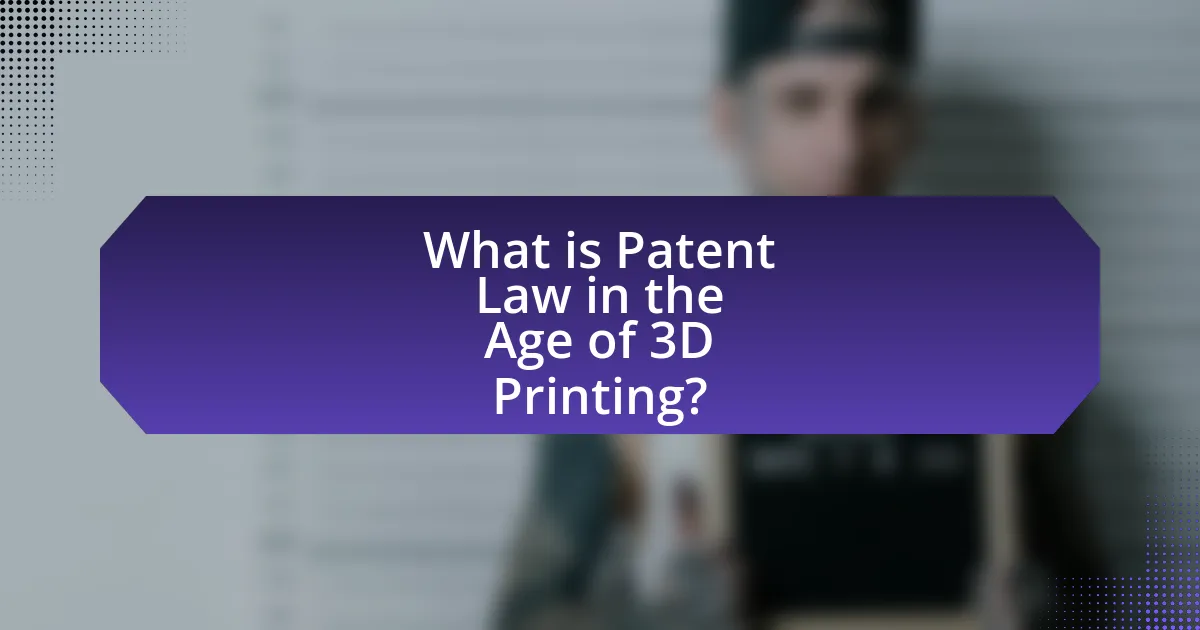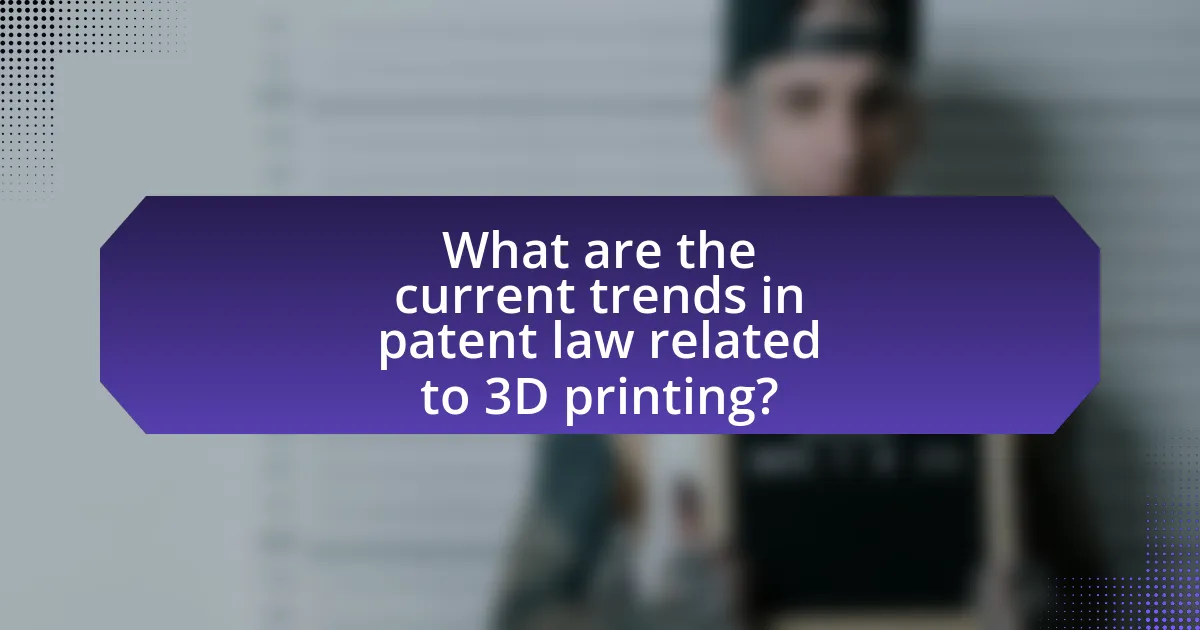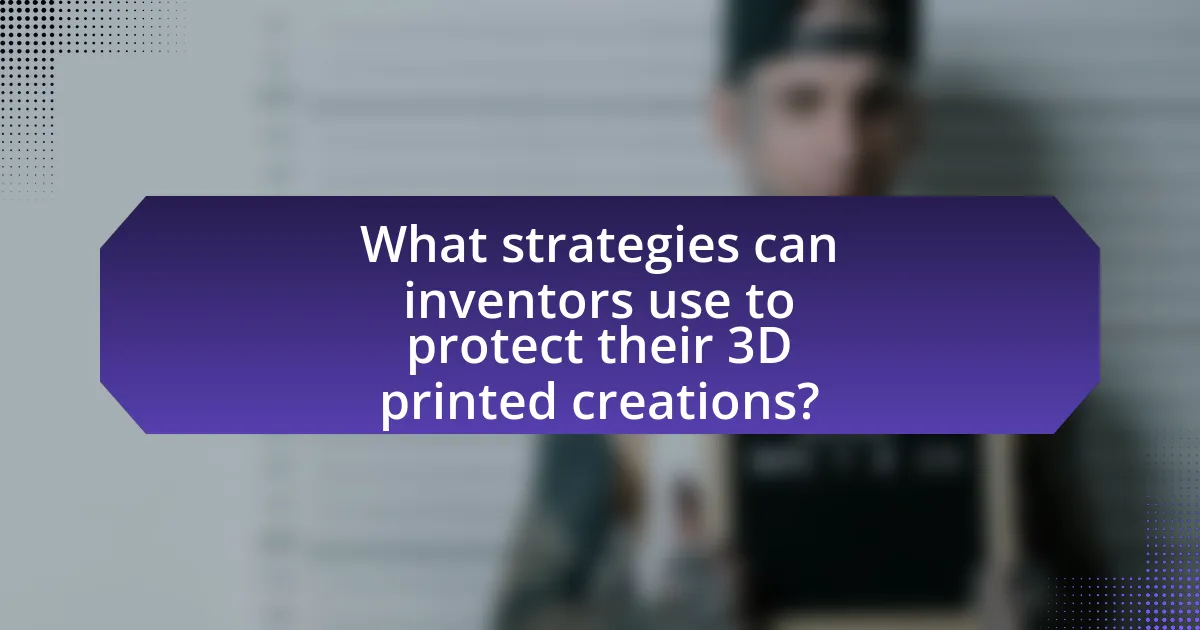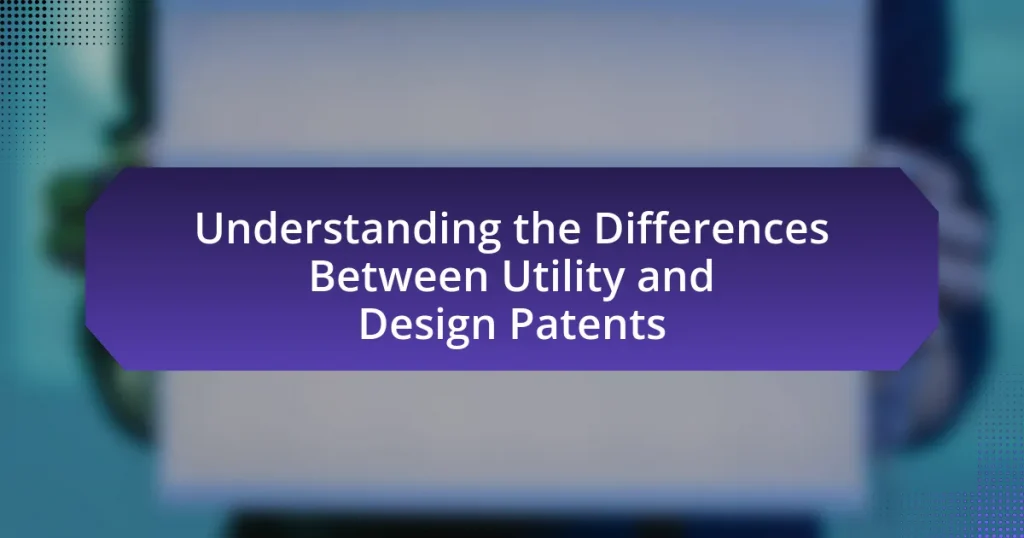Patent law in the age of 3D printing addresses the complexities of intellectual property rights as they relate to the production and distribution of 3D-printed objects. The rise of 3D printing technology has introduced challenges in enforcing existing patent laws, particularly regarding the replication of patented designs without authorization. Key legal issues include the applicability of traditional patent laws to 3D printed products, the implications for intellectual property rights, and the evolving landscape of patent infringement cases. Courts and patent offices are adapting to these challenges by updating legal frameworks and guidelines, while inventors are encouraged to utilize patents, copyrights, and trade secrets to protect their creations. The article explores current trends, legal challenges, and strategies for navigating the patent application process in the context of 3D printing.

What is Patent Law in the Age of 3D Printing?
Patent law in the age of 3D printing addresses the complexities of intellectual property rights as they relate to the production and distribution of 3D-printed objects. The rise of 3D printing technology has led to challenges in enforcing existing patent laws, as individuals can easily replicate patented designs without authorization. For instance, the U.S. Patent and Trademark Office has recognized the need for updated regulations to accommodate the unique aspects of 3D printing, such as digital file sharing and the potential for mass customization. This evolution in patent law is crucial to protect inventors while fostering innovation in a rapidly changing technological landscape.
How has 3D printing technology influenced patent law?
3D printing technology has significantly influenced patent law by challenging traditional notions of patentability and enforcement. The rise of this technology has led to increased concerns about intellectual property infringement, as individuals can easily replicate patented designs using 3D printers. For instance, the ability to produce complex objects at home raises questions about the applicability of existing patent frameworks, which were not designed to address the decentralized nature of 3D printing. Additionally, courts have begun to grapple with issues related to the definition of “making” and “using” a patented invention, as seen in cases like the 2016 decision in the case of “3D Systems, Inc. v. Formlabs, Inc.” where the court had to consider the implications of digital files in patent infringement. This evolving landscape necessitates adaptations in patent law to better protect inventors while addressing the unique challenges posed by 3D printing technology.
What are the key legal challenges posed by 3D printing?
The key legal challenges posed by 3D printing include issues related to intellectual property rights, liability for infringement, and regulatory compliance. Intellectual property rights are particularly complex, as 3D printing allows for the easy replication of patented designs, raising questions about who holds the rights to the original design versus the reproduced item. Liability for infringement becomes problematic when determining whether the user, the manufacturer of the 3D printer, or the software provider is responsible for unauthorized reproductions. Additionally, regulatory compliance challenges arise in ensuring that 3D printed products meet safety and quality standards, which can vary significantly across jurisdictions. These challenges necessitate ongoing legal adaptations to address the evolving landscape of technology and manufacturing.
How do traditional patent laws apply to 3D printed products?
Traditional patent laws apply to 3D printed products by protecting the intellectual property rights of inventors and manufacturers, similar to conventional manufacturing processes. Patent law grants exclusive rights to the patent holder, preventing others from making, using, or selling the patented invention without permission, regardless of whether the product is produced through traditional methods or 3D printing. For instance, if a 3D printed product incorporates patented technology, the act of printing that product without authorization constitutes patent infringement. This principle is supported by legal precedents that affirm the applicability of patent rights to various manufacturing technologies, including 3D printing, as established in cases like the 2016 decision in the case of Stratasys, Inc. v. ClearCorrect Operating, LLC, which highlighted the relevance of patent laws in the context of digital manufacturing.
What are the implications of 3D printing on intellectual property rights?
3D printing significantly complicates intellectual property rights by enabling the easy reproduction of patented designs without authorization. This technology allows individuals and businesses to create copies of products, which can infringe on existing patents, leading to potential legal disputes. For instance, a study by the European Patent Office in 2015 highlighted that 3D printing could undermine traditional patent enforcement mechanisms, as the digital files used for printing can be shared and modified easily, making it challenging to track and enforce patent rights. Additionally, the rise of 3D printing has prompted discussions about the need for new legal frameworks to address these challenges, as existing laws may not adequately protect inventors in this rapidly evolving landscape.
How does 3D printing affect patent infringement cases?
3D printing significantly complicates patent infringement cases by enabling the easy replication of patented designs. This technology allows individuals and businesses to produce items without the need for traditional manufacturing processes, often leading to unintentional or intentional infringement of existing patents. For instance, a study by the World Intellectual Property Organization (WIPO) highlights that the accessibility of 3D printing technology increases the risk of unauthorized reproduction of patented products, as users can create copies from digital files without direct access to the original product. Consequently, patent holders face challenges in enforcing their rights, as the decentralized nature of 3D printing makes it difficult to track and prove infringement.
What role does copyright play in 3D printed designs?
Copyright protects the original expression of ideas in 3D printed designs, granting creators exclusive rights to reproduce, distribute, and display their works. This legal framework ensures that designers can control the use of their creations, preventing unauthorized copying or modification. For instance, the U.S. Copyright Office recognizes 3D models as copyrightable if they exhibit originality and creativity, thus reinforcing the importance of copyright in safeguarding intellectual property in the realm of 3D printing.

What are the current trends in patent law related to 3D printing?
Current trends in patent law related to 3D printing include an increased focus on the challenges of patentability, particularly concerning the novelty and non-obviousness of 3D printed inventions. As 3D printing technology evolves, courts and patent offices are grappling with how to apply traditional patent principles to digital designs and additive manufacturing processes. For instance, the U.S. Patent and Trademark Office has issued guidelines emphasizing the need for clear distinctions between traditional manufacturing and 3D printing methods, which can complicate the patent application process. Additionally, there is a growing trend towards addressing issues of infringement, as the ease of replicating designs raises questions about liability and enforcement. Recent cases, such as the 2021 decision in the case of “3D Systems, Inc. v. Formlabs, Inc.,” highlight the legal complexities surrounding the protection of 3D printed products and the implications for intellectual property rights.
How are courts adapting to the challenges of 3D printing?
Courts are adapting to the challenges of 3D printing by updating legal frameworks and precedents to address issues related to intellectual property rights. For instance, courts are increasingly considering how traditional patent laws apply to digital designs and the reproduction of physical objects through 3D printing technology. A notable example is the case of Stratasys, Inc. v. ClearCorrect Operating, LLC, where the court examined the implications of 3D printing on patent infringement, leading to clarifications on the scope of patent protection in the context of digital files. This adaptation reflects a broader trend of judicial systems recognizing the need for legal clarity in an evolving technological landscape.
What recent cases have set precedents in this area?
Recent cases that have set precedents in patent law related to 3D printing include the case of Stratasys, Inc. v. ClearCorrect Operating, LLC, where the court ruled on the applicability of patent rights to 3D printed products. This case established that the unauthorized production of 3D printed items can infringe on existing patents, reinforcing the protection of intellectual property in the context of additive manufacturing. Additionally, the case of 3D Systems Corp. v. Formlabs, Inc. highlighted the importance of patent claims in the 3D printing industry, as it addressed the nuances of patent infringement concerning specific technologies used in 3D printing processes. These rulings underscore the evolving landscape of patent law as it adapts to technological advancements in 3D printing.
How are patent offices responding to the rise of 3D printing?
Patent offices are adapting to the rise of 3D printing by updating their patent examination processes and guidelines to address the unique challenges posed by additive manufacturing technologies. For instance, the United States Patent and Trademark Office (USPTO) has issued guidance on how to assess patentability for 3D printed inventions, emphasizing the need for clarity in claims and the consideration of prior art specific to 3D printing. Additionally, the European Patent Office (EPO) has been actively engaging with stakeholders to refine its approach to patent applications involving 3D printing, ensuring that the legal framework remains relevant and effective in protecting innovations in this rapidly evolving field. These responses reflect a recognition of the transformative impact of 3D printing on traditional manufacturing and intellectual property landscapes.
What are the potential future developments in patent law for 3D printing?
Potential future developments in patent law for 3D printing include the establishment of clearer guidelines for patentability, particularly concerning the originality and non-obviousness of 3D printed designs. As 3D printing technology evolves, legal frameworks may adapt to address issues such as digital rights management, the protection of software used in 3D printing, and the implications of user-generated content. Additionally, there may be an increase in litigation surrounding patent infringement as more individuals and companies utilize 3D printing for production, necessitating a reevaluation of existing patent laws to accommodate the unique challenges posed by this technology. These developments are supported by ongoing discussions in legal circles and academic research, highlighting the need for a responsive legal system that can keep pace with technological advancements.
How might legislation evolve to address 3D printing issues?
Legislation may evolve to address 3D printing issues by introducing specific regulations that clarify intellectual property rights and liability concerns. As 3D printing technology advances, lawmakers are likely to create frameworks that define ownership of digital designs, ensuring that creators are protected against unauthorized reproductions. For instance, the U.S. Patent and Trademark Office has already begun to explore how existing patent laws apply to 3D printed objects, indicating a shift towards more tailored legal standards. Additionally, international cooperation may be necessary to address cross-border challenges, as 3D printing can easily facilitate the replication of patented items across jurisdictions. This evolution in legislation will likely be informed by ongoing discussions among stakeholders, including manufacturers, legal experts, and policymakers, to balance innovation with protection of intellectual property rights.
What innovations could change the landscape of patent law?
Innovations such as blockchain technology, artificial intelligence, and 3D printing are poised to significantly change the landscape of patent law. Blockchain can enhance patent protection by providing a secure, immutable record of inventions and their ownership, which can streamline the process of proving originality and ownership in disputes. Artificial intelligence can assist in prior art searches and patent analysis, making it easier to assess the novelty of inventions and potentially reducing the backlog in patent offices. Additionally, 3D printing complicates traditional patent enforcement, as it allows for decentralized production of patented items, necessitating new legal frameworks to address infringement and licensing in this context. These innovations collectively challenge existing patent systems and require adaptations to ensure effective protection and enforcement of intellectual property rights.

What strategies can inventors use to protect their 3D printed creations?
Inventors can protect their 3D printed creations through patents, copyrights, and trade secrets. Patents provide legal rights to exclude others from making, using, or selling the invention for a specified period, typically 20 years, which is crucial for safeguarding innovative designs. Copyrights can protect the artistic aspects of 3D printed objects, ensuring that the creator retains rights over the visual design. Additionally, trade secrets can be employed to keep specific manufacturing processes or materials confidential, preventing competitors from replicating the invention. These strategies are supported by legal frameworks that recognize the unique challenges posed by 3D printing technology, allowing inventors to maintain control over their intellectual property.
How can inventors navigate the patent application process for 3D printed inventions?
Inventors can navigate the patent application process for 3D printed inventions by thoroughly researching existing patents, preparing detailed documentation of their invention, and filing a patent application with the relevant patent office. Researching existing patents ensures that the invention is novel and non-obvious, which are key criteria for patentability. Detailed documentation should include technical specifications, drawings, and descriptions of the 3D printing process used, as these elements help demonstrate the uniqueness of the invention. Filing the application involves completing the necessary forms and paying applicable fees, which varies by jurisdiction. According to the United States Patent and Trademark Office, a well-prepared application can significantly increase the chances of approval, as it provides clear evidence of the invention’s originality and utility.
What are the best practices for drafting patent claims for 3D printed products?
The best practices for drafting patent claims for 3D printed products include clearly defining the invention’s unique features, using precise language to describe the 3D printing process, and ensuring claims cover various embodiments of the product. Clear definitions help distinguish the invention from prior art, while precise language minimizes ambiguity, which is crucial in patent law. Additionally, including claims that encompass different materials and methods of 3D printing can enhance the patent’s scope and enforceability. For example, a patent claim that specifies both the design and the material used in the 3D printing process can provide broader protection, as seen in successful patents like those for specific 3D printing techniques in the medical device industry.
How can inventors ensure their designs are not easily replicated?
Inventors can ensure their designs are not easily replicated by obtaining patents, which legally protect their inventions from unauthorized use. A patent grants the inventor exclusive rights to their design for a specified period, typically 20 years, preventing others from making, using, or selling the invention without permission. Additionally, inventors can employ trade secrets, which involve keeping certain aspects of their designs confidential, thus making replication difficult. For instance, the Coca-Cola formula is a well-known trade secret that has been protected for over a century. By combining patent protection with trade secrets, inventors can create a robust defense against replication in the context of evolving technologies like 3D printing.
What resources are available for understanding patent law in 3D printing?
Resources available for understanding patent law in 3D printing include legal textbooks, online courses, and scholarly articles. Notable textbooks such as “Patent Law and Theory: A Handbook” by Charles R. Macedo provide foundational knowledge. Online platforms like Coursera and edX offer courses specifically addressing intellectual property in the context of 3D printing. Additionally, scholarly articles in journals like the “Journal of Intellectual Property Law & Practice” discuss recent developments and case studies related to patent law and 3D printing technologies. These resources collectively enhance comprehension of the complexities surrounding patent law in this evolving field.
Where can inventors find legal assistance for patent issues?
Inventors can find legal assistance for patent issues through specialized patent attorneys or law firms that focus on intellectual property law. These professionals are equipped to navigate the complexities of patent applications, infringement disputes, and licensing agreements. According to the American Bar Association, patent attorneys must have a technical background and pass the Patent Bar Exam, ensuring they possess the necessary expertise to assist inventors effectively. Additionally, organizations such as the United States Patent and Trademark Office provide resources and referrals to qualified legal professionals, further supporting inventors in their pursuit of patent protection.
What educational materials are available for learning about patent law?
Educational materials for learning about patent law include textbooks, online courses, legal journals, and government resources. Textbooks such as “Patent Law Essentials” by Alan L. Durham provide foundational knowledge, while online platforms like Coursera and edX offer courses from universities covering various aspects of patent law. Legal journals, including the “Journal of Intellectual Property Law & Practice,” publish articles and case studies that enhance understanding. Additionally, resources from the United States Patent and Trademark Office (USPTO) offer guidelines and educational materials specifically related to patent law. These materials collectively support a comprehensive understanding of patent law principles and practices.
What are the common pitfalls to avoid in patenting 3D printed inventions?
Common pitfalls to avoid in patenting 3D printed inventions include failing to conduct a thorough prior art search, neglecting to adequately describe the invention, and overlooking the importance of claims drafting. A thorough prior art search is essential to ensure that the invention is novel and non-obvious, as required by patent law; without this, applicants risk rejection or invalidation. Additionally, insufficiently describing the invention can lead to a lack of clarity, making it difficult for others to understand the scope of the patent, which can result in enforcement challenges. Finally, poorly drafted claims may not adequately protect the invention, leaving it vulnerable to infringement or competition. These pitfalls can significantly hinder the patenting process and the protection of intellectual property in the rapidly evolving field of 3D printing.



